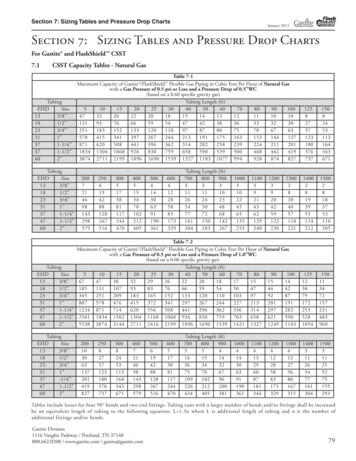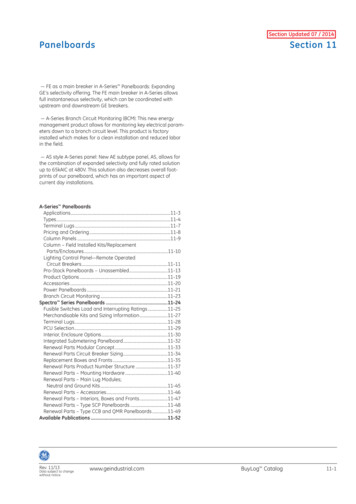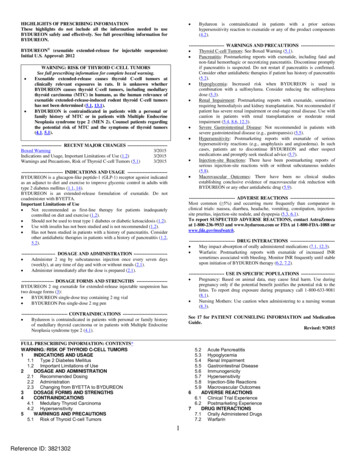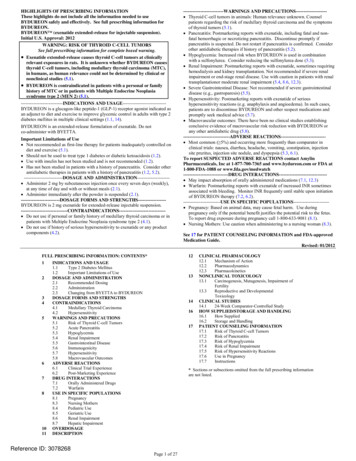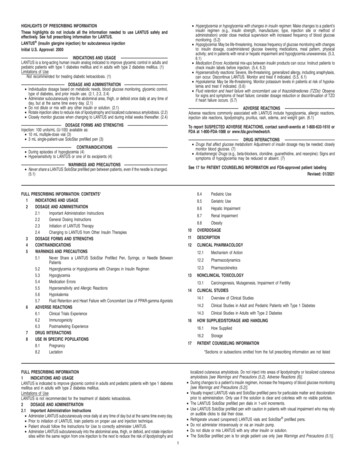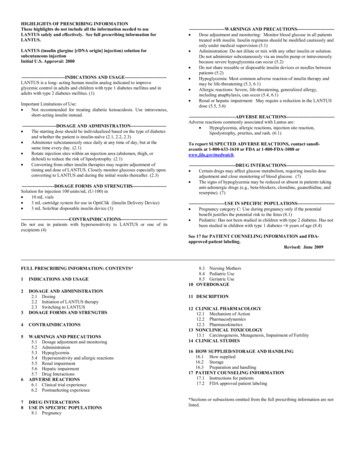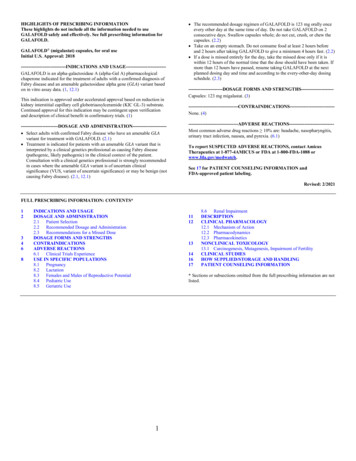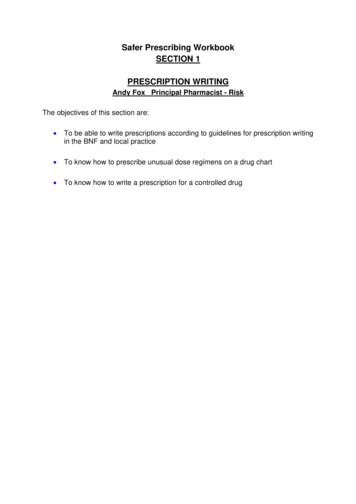
Transcription
Safer Prescribing WorkbookSECTION 1PRESCRIPTION WRITINGAndy Fox Principal Pharmacist - RiskThe objectives of this section are: To be able to write prescriptions according to guidelines for prescription writingin the BNF and local practice To know how to prescribe unusual dose regimens on a drug chart To know how to write a prescription for a controlled drug
PRESCRIPTION WRITINGErrors occur when planned actions fail to achieve a desired outcome.There are two main error types Slips and lapses, where the actions do not go according to plan e.g. intendingto write 5mg of a drug but unintentionally writing 50mg Mistakes, where the plan itself is wrong e.g. writing 50mg of a drug notknowing the usual dose is 5mg.It is not known how often prescribing errors occur. However it is known that patientscan be harmed as a result of some prescribing errors. Prescribing errors can occuras a result ofInadequate knowledge of the patient and their clinical statusInadequate drug knowledgeCalculation errorsIllegible handwritingdrug name confusionpoor history takingFatigue and workload may also contribute to the risk of slips and lapses.It is important that all prescribers are aware of the risks and principles of safeprescribing.Allergy documentationBefore writing any prescription check the patient’s allergy status for contraindicateddrugs, and confirm that the drug you wish to prescribe is safe for the patient. Checkalso for drugs which the patient may not be able to tolerate because of their clinicalconditions e.g. in G6PD deficiency, chronic renal impairment, myasthenia etc.Illegible prescriptionsThe following are examples of where drug names have been misinterpreted as aresult of poor handwriting. Patients were harmed as a resultA prescription for amoxycillin was misread as Daonil (an oral hypoglycaemic). Thepatient suffered permanent harm as a result of prolonged hypoglycaemia.2
A prescription for Isordil (isosorbide mononitrate) was misread as Plendil (felodipine)(Ref. BMJ 1999; 319: 1456)What should the nurses administer against this prescription?Or this prescription?3
ENSURE YOUR PRESCRIPTIONS ARE LEGIBLE AND CANNOT BEMISINTERPRETED.Write out the names of the following drugs in your usual handwriting. Get a nonmedically trained friend to transcribe them. If they can transcribe them accuratelythen your handwriting is likely to be CarbimazoleThyroxineCefriaxoneCeftazidimeDose unitsAs well as drug names, dose units can be misinterpreted. This is especiallyimportant in paediatrics and for drugs where there is a wide variation in the dose thatcan be administered e.g. opiates A patient died after receiving an epidural infusion containing 30mgdiamorphine in 10mls instead of 3mg in 10mls. The doctor's prescription hadbeen misread.(The Times. July 3 1996)Write the word units in full Abbreviation of the word units to IU resulted in the administration of 10-foldoverdoses of insulin when prescriptions for 6IU were misread as 61 units(PharmJ 2001;267:193)Always prescribe in whole units avoiding the need for decimal points whereverpossible. Milligram to microgram conversions can result in 10-fold errors. A baby weighing 3.2kg was prescribed 10micrograms/kg of digoxin. When theprescription was written the decimal point was omitted and a dose of320microgram was prescribed and administered.(BBC News Online, March 9, 1999)Write up the following doses in microgramsDigoxin 0.0625mgThyroxine 0.05mgClonazepam 0.1mgOctreotide 0.05mgIpratropium inhaler 0.02mg per doseAtropine 0.6mg4
Prescribing unusual frequenciesMistakes may occur when drugs are not given every day, or the frequency changes.A small number of medicines are only taken weekly e.g. oral methotrexate, or areformulated to be taken once weekly instead of once daily e.g. alendronate 10mgdaily/alendronate 70mg once a week. If the prescription is not clear weekly dosesmay be given daily causing patient harm.Example 1Prescription for weekly alendronateOn the first drug chart it is possible for the patient to be administered 70mg daily.The weekly instruction can easily be overlooked and the drug given at 8am everyday.On the second drug chart the administration record is crossed through on the dayswhen doses are not due. The drug cannot be given and the risk of inadvertent dailyadministration of a weekly drug is avoided.Chart 1Chart 2IMPORTANT: Oral Methotrexate is prescribed to be taken once weekly for psoriasisand rheumatoid arthritis. Patients have been harmed when methotrexate has beeninappropriately prescribed or taken daily in error. National Guidance has beenissued to try to avoid such harm from occurring.ENSURE DOSES NOT DUE ARE CROSSED THROUGH ON THE CHART5
AnswersDigoxin 62.5micrograms, thyroxine 50 micrograms, clonazepam 100micrograms, octreotide 50 micrograms, ipratropium 20micrograms, atropine600microgramsExample 2Prescription for amiodarone loading dosesAmiodarone is typically initiated by giving 200mg tds for 7 days, then 200mg bd for 7days, then 200mg od for 7 days. Because the drug charts are valid for 14 daysparticular care is needed when the prescription is transcribed. There is a risk thatamiodarone is transcribed as tds. Always transcribe the drug chart using the latestdosing regimen6
PRESCRIPTION WRITING STANDARDSLegal responsibility for prescribing lies with the practitioner who signs the prescription.GENERALThe patientAll drug charts and TTAs MUST include the patient's surname and given name, their date ofbirth, date of admission, consultant.Where dosing is weight dependent e.g. paediatrics, low molecular weight heparins, orpatient is significantly under- or overweight, the weight should be documentedAllergy boxBoth positive and negative allergy histories and drug sensitivities MUST be documented.Where allergy history is positive symptoms of the allergy should be described.Drug nameWrite approved names, legibly and correctly spelt.Do NOT use abbreviationsPrint if necessaryDoseNO trailing zeroes (5mg NOT 5.0mg)Quantities of 1gram or more should be written (1g, 1.5g etc.)Quantities less than 1g should be written in milligrams (500mg NOT 0.5g)Quantities less than 1mg should be written in micrograms (100micrograms NOT 0.1mg)When decimals are unavoidable the decimal point MUST be preceded by another figure(0.5mls NOT .5mls)Dose unitsThe words micrograms, nanograms and units MUST NOT be abbreviated.The term millilitre is abbreviated to ml NOT cc or cm3FrequencyThe dose and frequency must be specified.For As Required prescriptions the minimum dose interval MUST be specified (6hours NOTqds)Start dateSpecify the date the drug was FIRST prescribed/due this admission (not the date the chartis rewritten)IndicationFor As required prescriptions the indication should be includedSignaturePrescriptions must be signed in ink. Bleep/contact numbers should be included so thatprescribers can be contacted if necessaryCONTROLLED DRUG TTAsMust be written entirely in the doctor's own handwriting and must include:The patient's name and address (or unit number)The form (e.g. tablets, liquid) and the strength of the preparationThe total number of dose units to be supplied in both words and figuresThe dose.Examples are included in the BNF and the King's Formulary.INTRAVENOUS PRESCRIPTIONSDrugs for continuous infusion should be written on an IV Fluid prescriptionThe drug and quantity must be specifiedThe name of the infusion solution (diluent) must be specifiedThe rate of administration must be specified in mls/min or mls/hrUNUSUAL REGIMENSFor doses taken intermittently or at irregular intervals boxes corresponding to doses that arenot due MUST be crossed out. e.g. weekly alendronate, 3x week erythropoietinDISCONTINUING MEDICATIONS and CHANGING DOSESCross off the prescribing section of the drug chart AND the administration section. Sign anddate the chart.If the dose is changed it must be rewritten with the NEW start dateADDITIONAL DRUG CHARTSInsulin and warfarin must be prescribed on drug charts with the instruction see insulinprescription or see anticoagulation prescription. Doses must NOT appear on two separatecharts concurrently.Only ONE drug chart should be in use at once.Two drug charts are ONLY permitted if the number of drugs currently prescribed exceedsthe number of spaces on the chart. Where more than one chart is used they must belabelled '1 of 2', 2 of 2' etc.Where two charts are necessary they must be fastened together.7
Controlled drugsThe way in which CD prescriptions are written is strictly defined and must be adheredto. Contrary to popular belief this is not difficult honest.The only difference between a CD prescription and any other prescription is that thepreparation to be supplied must be defined, e.g. morphine sulphate 10mg tablets(Sevredol), and the total number of units of that preparation specified in both wordsand figures - see attached example. Also it ALL has to be written in the doctors ownhandwriting (which means that Pharmacy cannot make changes for you!)If still in doubt consult the guidelines in the BNF or contact the pharmacy for advice8
Write the name of the drugAnd the formulationInclude the dose and thefrequencyThen the number of tablets you want thepatient to be given in numbers (56)and in words ( fifty-six)Then remember to sign and date the prescription in the usual way.9
This section of the workbook contains tasks for you to complete.You might find it helpful to do this alone and then discuss the answers in yourgroups.Task 1Mr AB was admitted through casualty last night and a drug chart has been written.Comment on the drug chart and make any necessary amendments for it to conformto Trust prescription writing standards.10
Task 2On a ward round the decision is made to commence Mr CD on heparinthromboprophylaxis. The consultant asks you to prescribe twice daily heparin. Writea prescription for this patient11
Task 3Mrs PQ, a patient with breast cancer and bony metastases, is to be discharged fromhospital. Her analgesic requirements have been stabilized while she has been inhospital and she needs a supply of Morphine Sulphate tablets to go home on. (Aswell as her usual medication she will also need painkillers for possible breakthroughpain and regular laxatives)Write a controlled drug TTA corresponding to this regular morphine sulphateprescription.12
13
Task 4The following prescriptions contain errors. Comment on the prescriptions and thinkabout how these errors might have occurred, what the risks are and how they couldbe avoided.1. MixtardWhat are the risks?How might this have occurred?How could the risks be avoided?The insulin prescription charts used at SUHT’s are designed to avoid this type oferror. The dose in units is prescribed directly onto the insulin chart. There is noneed to write the word units, or any abbreviation of the word units after the dose.Familiarise yourself with the insulin chart.14
2. RamiprilWhat are the risks?How might this have occurredHow could the risks be avoided?3. Comment on this prescriptionWhat are the risks?How could this have occurredHow could the risks be avoided?15
4. What is this drug?What are the risks?How might this have occurred?How could the risks be avoided?5. What are the risks with this prescription?How could this have occurred?How could these risks be avoided?16
INFORMATION SOURCESThe objectives of this section are: To be able to interpret drug dosing information in the BNF To know how to use the BNF, pharmacy and computer-based prescribingdecision support to access information about drug treatments including druginteractions To know the difference between the different formulations of oral morphineand the implications for prescribing Be aware of the role of the Medicines Information Department17
IntroductionBritish National Formulary (BNF)This is published twice a year by the British Medical Association and the RoyalPharmaceutical Society of Great Britain. It is designed to be a concise, first-linereference source on the prescribing, dispensing and administration of drugs. It willusually provide information on UK indications, dosages for adults and any licensedpaediatric dosages, adverse effects and different formulations in which a drug isavailable.The BNF comprises a set of chapters, appendices and indexes. The introductorychapters provide some general information such as guidance on prescribing andprescribing in palliative care. Most other chapters cover a single area of medicinee.g. cardiovascular system, and consist of a section of general information followedby drug monographs.The appendices comprise topics such as drug interactions, liver disease, renalimpairment, pregnancy, breastfeeding and intravenous administration.Other helpful sections of the BNF include the list of drugs to be avoided in acuteporphyrias, summaries of antibacterial treatment and prophylaxis, drugs to beavoided in G6PD deficiency and the British Thoracic Society Guidelines for themanagement of asthma. There is also information on relevant NICE guidanceincluded throughout.The content of the BNF is drawn from a variety of sources and information may notalways reflect licensed indications or doses, although it will often state if it is anunlicensed indication. It does not usually give details about the frequency, clinicalpresentation or management of side effects and interactions. It is generally notreferenced and chapters on specialist areas like oncology are brief, as professionalsworking in these fields should have access to detailed literature.The appendices do give some guidance on prescribing in problem areas such aspregnancy and breast-feeding, but these should be used in conjunction with morespecialist resources where necessary.The BNF is available free of charge on-line at www.bnf.org.uk.BNFCThe BNF for children contains all the licensed and unlicensed doses of medicationused in children. This is the primary source of
A small number of medicines are only taken weekly e.g. oral methotrexate, or are formulated to be taken once weekly instead of once daily e.g. alendronate 10mg daily/alendronate 70mg once a week. If the prescription is not clear weekly doses may be given daily causing patient harm.



